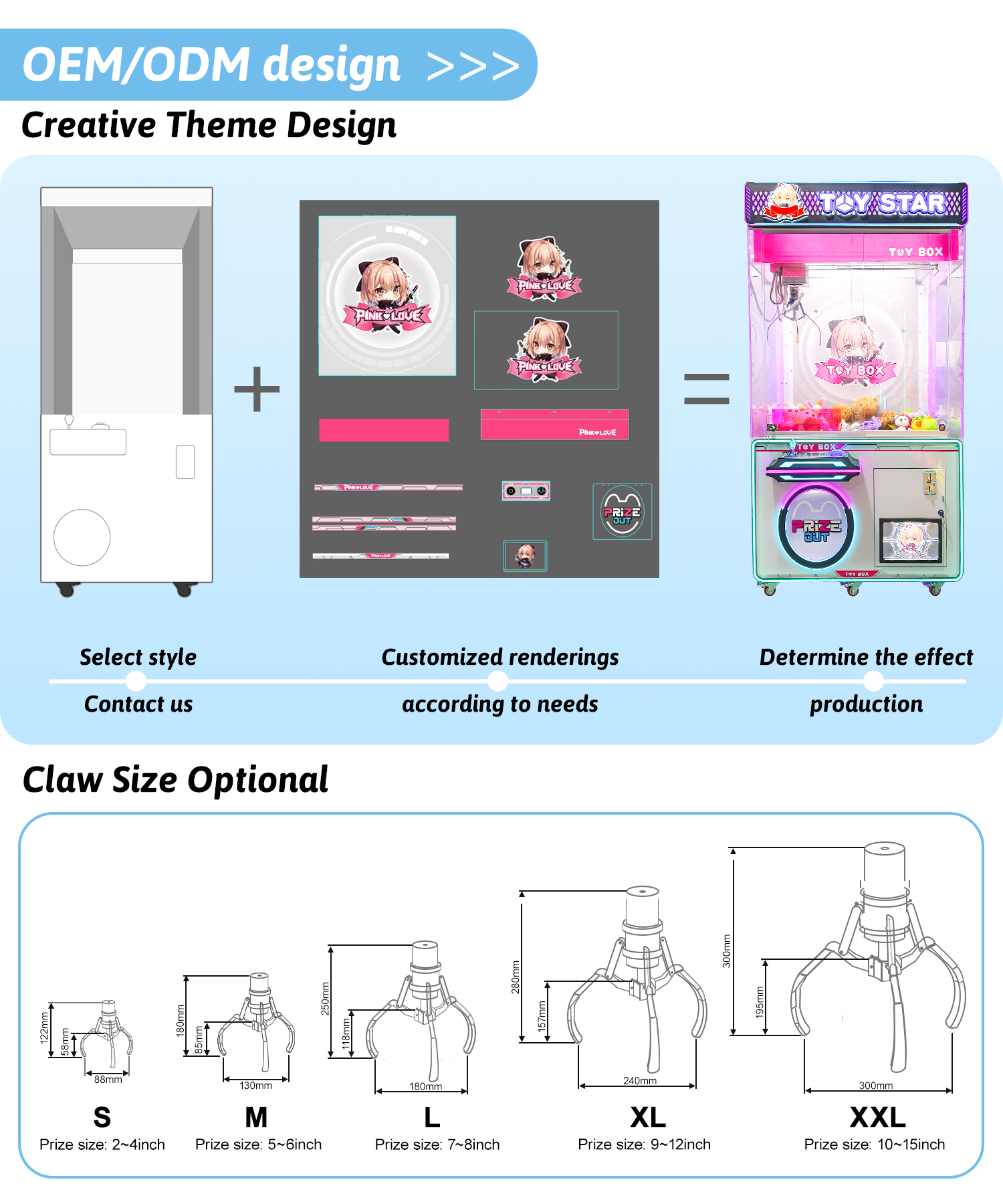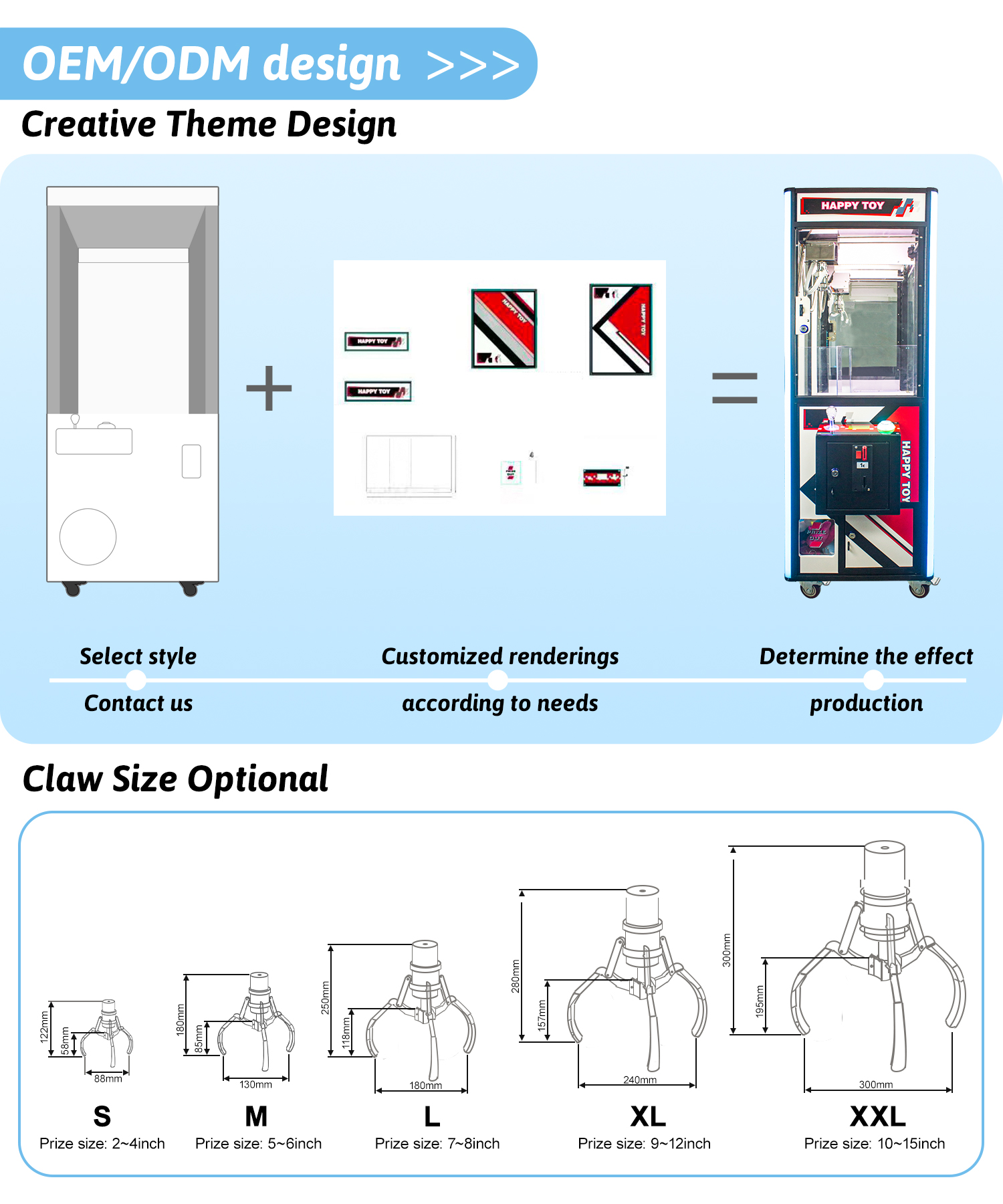For optimal performance and longevity, claw machine owners should regularly check and adjust the claw’s grip, inspect and clean coin acceptors, test and calibrate controls, monitor the prize dispensing system, and examine internal wiring to ensure safety and functionality, reducing downtime by up to 20%.
Table of Contents
ToggleCheck and Adjust the Claw Grip
“Hey, have you noticed the claw isn’t grabbing as well lately?” This might be a common question among arcade staff or owners monitoring their machines. Ensuring the claw grip is properly adjusted is crucial not only for player satisfaction but also for the profitability of the machine.
How Often Should You Check
Frequency is important, depending on the machine’s location and usage rate. For machines in high-traffic areas, it’s recommended to check the claw grip weekly. Our data shows that high-usage machines, when adjusted weekly, can increase their success rate by 15%, which is essential for maintaining player interest and machine revenue. For lower-traffic areas, checking every two weeks might be sufficient.
Steps to Adjust the Claw Grip
- Access the Machine Settings: First, ensure you have access to the machine’s control panel. This usually requires a key to open the front or back of the machine. Once you access the control panel, you will see several adjustment knobs or a touchscreen interface, depending on the model and age of the machine. “Make sure to disconnect the power before adjusting the settings, for safety,” emphasizes an experienced technician.
- Adjust the Tension: The claw’s strength is typically controlled by a knob or digital settings, depending on the machine’s model. “You want the claw to be strong enough to pick up prizes, but not so strong that it makes the game easy,” advises an experienced technician. In practice, adjusting the claw’s strength to achieve about one successful grab in ten plays is ideal for balancing challenge and player satisfaction.
- Test the Adjustments: Place various types of prizes in the machine and observe the claw’s interaction with them. Adjust until you find a balance that challenges players without frustrating them.
Fine-Tuning for Different Prizes
Different prizes require adjustments to the claw’s grip. “For plush toys, a softer grip is needed, while more solid items like electronics may need a stronger grip to prevent them from slipping,” explains a machine operator. Adjusting the claw’s tension to accommodate different types of prizes, based on the weight and material of the prizes, ensures that the claw can effectively and fairly grab the prizes.
Watch for Wear and Tear
Regularly check the claw for any signs of wear or damage. Bent claws or worn grips can greatly reduce the machine’s functionality. A maintenance data analysis shows that replacing a worn claw can improve grip efficiency by up to 20%, significantly enhancing the machine’s overall performance and player gaming experience.

Inspect the Coin Acceptors
Routine Inspections Are Key
Maintaining the coin acceptors in optimal condition is critical for the smooth operation of your claw machine. Players get frustrated with machines that reject their coins, which can lead to decreased play and revenue. “A malfunctioning coin acceptor can turn a popular machine into one that’s ignored,” notes a veteran arcade manager.
Frequency of Inspections
It’s advisable to inspect the coin acceptors at least once a month. For machines with heavy usage, consider increasing the inspection frequency to bi-weekly. This can prevent most issues related to coin jamming and recognition errors.
Steps for Inspecting Coin Acceptors
- Visual Inspection: Begin with a thorough visual check for any obvious signs of dirt, grime, or obstructions. These can interfere with the acceptor’s ability to read coins properly.
- Cleaning: Use a soft cloth and a mild cleaner to gently clean the coin slots and the internal mechanisms. Avoid harsh chemicals that could damage the components.
- Testing Functionality: Insert various denominations of coins to ensure that the acceptor is not only taking the coins but also recognizing them correctly. “Sometimes, a simple recalibration can resolve most recognition issues,” a technician might suggest.
- Check for Wear and Damage: Look for any signs of wear or mechanical damage. Replace parts that appear worn out or damaged to prevent future problems.
Dealing with Common Issues
Frequent issues with coin acceptors include jamming, misrecognition, and slow response. “Regular maintenance includes checking for loose wires or connections within the coin mechanism, which can impact its performance,” an arcade technician points out. Adjusting the sensors and recalibrating the acceptor software may be required if consistent issues are noted during testing.
Record Keeping
Maintain a log of all maintenance and inspections performed on the coin acceptors. This documentation can help identify recurring issues and is invaluable for troubleshooting future problems.
Test and Calibrate the Joystick and Buttons
Ensure Responsiveness and Accuracy
The joystick and buttons are the main interface for players interacting with the claw machine. Ensuring these control elements are responsive and accurate is crucial for delivering a high-quality gaming experience. If the joystick or buttons are sluggish or inaccurate, it will directly affect the players’ scores and satisfaction. “The performance of the joystick and buttons directly determines the overall player experience,” explains an arcade manager.
Frequency of Inspection
It is recommended to conduct a comprehensive test and calibration of the joystick and buttons once a month, especially for machines that are heavily used. This not only ensures the performance of the equipment but also helps identify and resolve issues before they become serious.
Steps for Testing and Calibration
- Visual Inspection: Start by checking the joystick and buttons for any physical damage or signs of wear. Look for any loose parts or unusual wear, which could affect the smoothness of operation.
- Functional Testing: Operate the joystick and press all the buttons, checking for any delays or non-responsiveness. Ensure that the control in each direction precisely manipulates the movement of the claw.
- Calibration: Adjust the sensitivity settings of the joystick and buttons according to the manufacturer’s manual. In most modern machines, this can be done through a built-in menu system.
- Re-testing: After adjustments, conduct another round of comprehensive testing to ensure all adjustments have enhanced the device’s responsiveness and accuracy. Observe whether the movement of the claw is strictly synchronized with the commands from the joystick.
Addressing Common Issues
If problems with the joystick or buttons are discovered during testing, more in-depth maintenance might be necessary. For instance, some issues may stem from loose internal wiring or damage, requiring more detailed technical intervention to resolve. “Regular maintenance can prevent these issues, ensuring the equipment always remains in optimal condition,” adds a technician.

Monitor the Prize Dispensing System
Ensuring Reliability in Prize Delivery
The prize dispensing system is a critical component of the claw machine, directly impacting player satisfaction. A reliable dispensing system not only secures a positive experience for players but also helps maintain the reputation of your arcade. “When players win, they expect their prize to be delivered smoothly and without hassle,” notes an arcade operations manager.
Frequency of Monitoring
Regular checks of the prize dispensing system are recommended. For high-traffic machines, monitoring should be done weekly to ensure that no mechanical failures or jams are occurring. In less frequented machines, a monthly check can suffice.
Steps for Monitoring the Prize Dispensing System
- Visual Inspection: Begin with a thorough visual inspection of the prize chute and the area where prizes are stored. Check for any obstacles or debris that could block the path of the prizes.
- Mechanical Testing: Operate the machine and win a few prizes to test the actual dispensing process. Pay attention to how smoothly the prizes move through the chute.
- Sensor Check: Many modern claw machines are equipped with sensors that detect whether a prize has been successfully dispensed. Test these sensors to ensure they are functioning correctly and not falsely signaling a blockage or failure.
- Adjustments and Repairs: If any issues are found during the inspection or testing phases, make the necessary adjustments or repairs immediately. This might include clearing blockages, recalibrating sensors, or replacing worn parts.
Handling Common Problems
Common issues with the prize dispensing system include jams, slow prize delivery, and sensor errors. Regular maintenance and careful monitoring can largely prevent these issues. “Staying proactive about maintenance helps us minimize downtime and keeps the games running smoothly,” a technician explains.
Examine Internal Wiring Regularly
Maintaining Electrical Safety and Functionality
The internal wiring of a claw machine is essential for its overall operation and safety. Faulty or aged wiring can lead to electrical hazards, machine malfunctions, or inconsistent gameplay, which can ultimately detract from the user experience. “Proper wiring checks ensure that the machine functions smoothly and safely,” a seasoned arcade technician emphasizes.
Frequency of Examination
It is advisable to examine the internal wiring of the claw machine every quarter. For machines that operate under high usage or in environments that may accelerate wear (like high humidity or temperature fluctuations), increasing the frequency of inspections to monthly checks is recommended.
Steps for Examining Internal Wiring
- Power Down the Machine: Always ensure the machine is powered off and unplugged before beginning any inspection. This is crucial for safety and prevents any accidental damage or injury.
- Visual Inspection: Open the machine’s access panel and visually inspect all wiring for signs of wear, fraying, or corrosion. Look for any loose connections or damaged insulation that could pose a risk.
- Test for Continuity: Use a multimeter to test the continuity of the wires. This will help identify any broken or shorted wires that may not be immediately apparent from a visual inspection.
- Check Connections: Ensure that all electrical connections are tight and secure. Loose connections can cause intermittent power issues and affect the machine’s performance.
- Replace or Repair: If any issues are found, such as frayed wires or corroded connectors, replace or repair them immediately. Delaying repairs can lead to more significant problems down the line.
Handling Common Electrical Issues
Common electrical issues in claw machines include short circuits, loose connections, and worn-out wires. Regular checks and timely repairs can prevent these problems from affecting gameplay. “Catching and addressing these issues early is key to maintaining the reliability and longevity of the machine,” an arcade maintenance manager advises.








